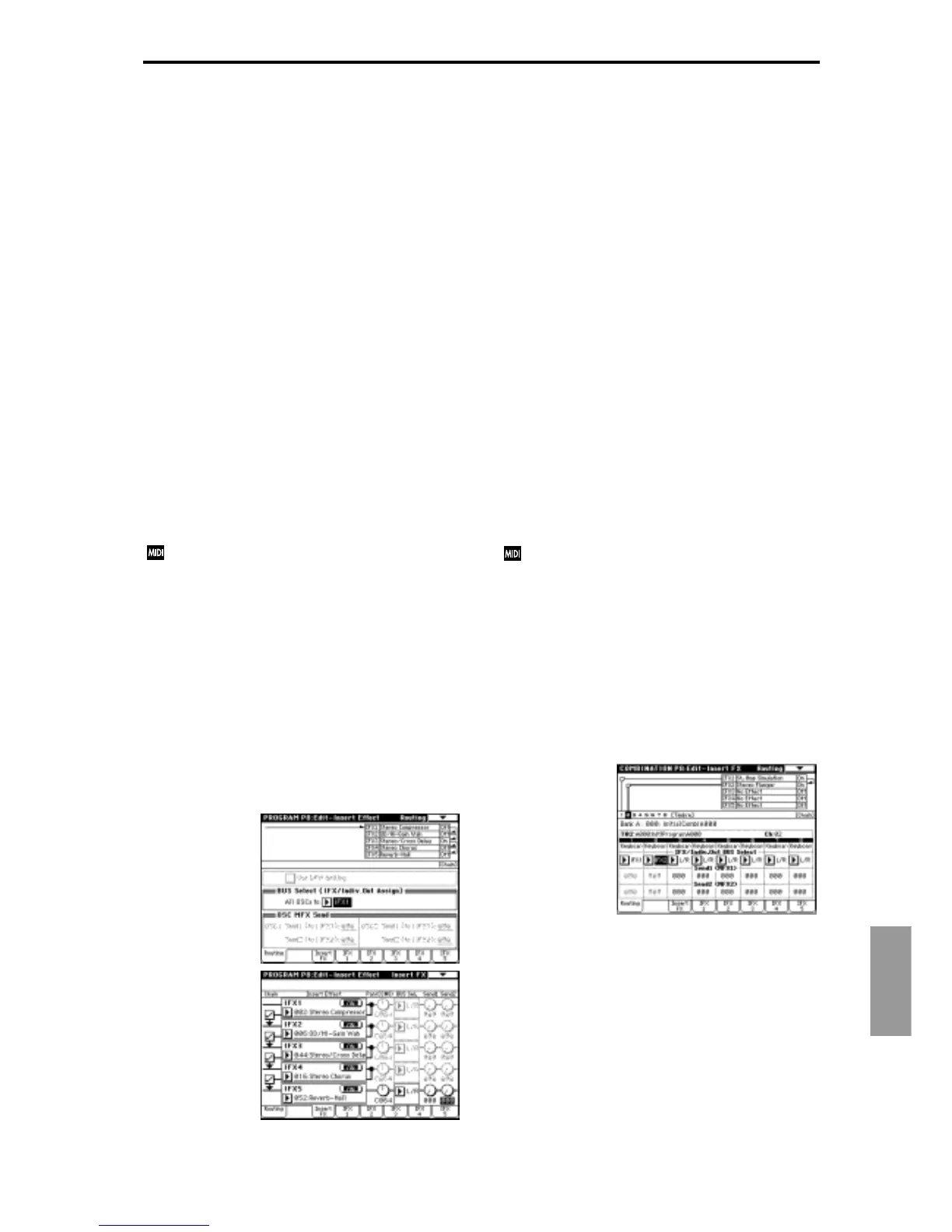Effect
147
2. Routing
You can use up to five channels (IFX 1, 2, 3, 4, and 5) for the
Insert Effects in any mode.
2–1. Program mode
Use “BUS Select” (Program P8: 8–1c) to set the destination bus
of the oscillator output.
L/R: The signal is not sent to the Insert Effects. Instead, it is
sent to AUDIO OUTPUT (MAIN) L/MONO and R after the
Master EQ.
IFX1–5: The signal is sent to Insert Effects IFX 1, 2, 3, 4, 5.
1, 2, 3, 4, 1/2, 3/4: The signal is sent to AUDIO OUTPUT
(INDIVIDUAL) 1, 2, 3, 4 (
☞p.153 “Individual Outputs”).
The signal is not sent to the Insert Effects, Master Effects,
and or Master EQ.
Off: The signal is not sent to AUDIO OUTPUT (MAIN L/
MONO, R, (INDIVIDUAL) 1, 2, 3, or 4. (After the Master
Effects, the signal is output to AUDIO OUTPUT (MAIN).)
Select this option if you connect the Insert Effects with the
Master Effects in series, with the send level specified by
“Send1 (MFX1)” and “Send2 (MFX2).”
Use “Send1 (to MFX1)” and “Send2 (to MFX2)” (Program
P8: 8–1d) to specify the send level for the Master Effects.
This setting is effective if “BUS Select” is set to L/R or Off.
If “BUS Select” (Program P8: 8–1c) is set to IFX1–5, use
“Send1” and “Send2” (Program P8: 8–2a) to specify the send
level of the post-IFX signal (
☞“3. Mixer”).
Send1 responds to MIDI Control Change CC#93, and
Send2 responds to MIDI Control Change CC#91. At
this time, the actual send level uses the value of the
Send 1 and 2 settings for Oscillators 1 and 2, multiplied
by the Send 1 and 2 values received via MIDI.
If you are connecting the Insert Effects in series, check the
“Chain” box (Program P8: 8–2a). If you check the box that is
located between IFX1 and IFX2, the output signal from IFX1
is sent to IFX2. When the Insert Effects are connected in
series, the values of the “Pan (CC#8),” “BUS Select,”
“Send1,” and “Send2” parameters for the post-IFX signal
will be used (
☞“3. Mixer”).
The following figure shows an example of Oscillators 1 and
2 outputs being sent to IFX1. Check the “Chain” box to con-
nect IFX1, 2, 3, 4, and 5 in series in this order. The “Pan
(CC#8),” “BUS Select,” “Send1,” and “Send2” parameters
for the post-IFX5 signal will be used.
— Settings for drum programs —
If you have selected “Drums” for “Oscillator Mode” (Pro-
gram P1: 1–1a) of a Program, the “USE DKit Setting” box
(Program P8: 8–1b) becomes available. If you check this box,
“BUS Select” (Global P5: 5–2b) for each key of the selected
DrumKit becomes effective.
For example, you can send a snare sound to IFX1 to apply
the Gate effect, a kick sound to IFX2 to apply EQ, and other
sounds to AUDIO OUTPUT (MAIN) L/MONO and R with-
out applying any Insert Effects. If you de-select the box, all
drum instrument outputs are sent to the bus specified by
“BUS Select” (Program P8: 8–1c). You may apply any Insert
Effects to all drum instruments, regardless of the DrumKit
settings.
2–2. Combination, Sequencer, and Song Play
modes
Use “BUS Select” (P8: “Routing” tab in each mode) for tim-
bres (Combination) and tracks (Sequencer, Song Play) to
select an Insert Effect to apply to the corresponding timbres
and tracks. You can route multiple timbres and tracks to a
single Insert Effect.
As with Program mode, select L/R, IFX1–5, 1–4, 1/2, 3/4, or
Off for each timbre and track.
“Send1 (MFX1)” and “Send2 (MFX2)” become available if
“BUS Select” has been set to L/R or Off.
If IFX1–5 is selected, use “Send1” and “Send2” for the post-
IFX signal (
☞“3. Mixer”).
Send1 responds to MIDI Control Change CC#93, and
Send2 responds to MIDI Control Change CC#91. At
this time, the actual send level uses the value of the
Send 1 and 2 settings for Oscillators 1 and 2 of the Pro-
grams (selected for the timbres and tracks), multiplied
by the Send 1 and 2 values received via MIDI (
☞p.151
“Send Level”).
The following figure shows an example of Combination
mode. The Timbre 1 output is sent to IFX1 and the Timbre 2
output is sent to IFX2 according to the “BUS Select” setting.
Other timbres are sent to L/R. The output signal passes
through the Master EQ, then goes to AUDIO OUTPUT
(MAIN) L/MONO and R. It is not routed to the Insert
Effects.

